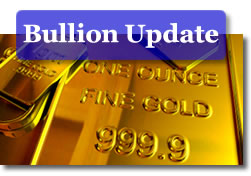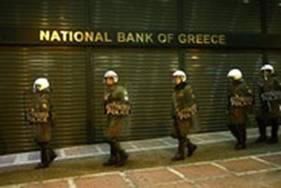 Upside-Down Views and Hot Pics From Down Under
Upside-Down Views and Hot Pics From Down Under
Good Day,
Gold’s overnight range tightened a bit further, as risk aversion ahead of the US payroll data kept speculators largely sidelined. While the short squeeze in the euro appears to have run out of most of its steam, the dollar remained firm near 80.50 on the trade-weighted index as its traders were also reluctant to dismiss Thursday’s impressive turnaround and cash in on their gains before learning what the jobs picture might look like this morning.
Greece-oriented worries continued to underpin the generally cautious mood and albeit the trade appeared bearish on the US jobs data (weather is thought to have wreaked some short-term havoc with the numbers — havoc to the tune of perhaps 50,000 to 90,000 jobs) one Aussie currency trader cautioned that with that kind of ‘X-factor’ in the equation, the data could ‘throw anything up.’ Today is pilgrimage day for Greece’s Prime Minister Papandreou. He will visit that most special of places –Germany– in his quest to secure at least a pledge that help might come when/if his country’s financial/economic ship lists too far to offer safety for those aboard.
Despite the importance of the Prime Minister’s visit, it was learned this morning that Germany and the Chairman of the group of countries using the euro ruled out immediate financial aid for Greece before the talks. For the moment, this is what you might see when walking down to the bank in Athens…

Reuters.
Mr. Papandreou’s odyssey comes at a time when the government has already angered throngs of Greeks with its latest round of austerity measures –most of which are seen by some firms with exposure to Greek debt, such as Invesco Ltd. for example, as insufficient to lure buyers to take up…more Greek debt. The firm, which manages some $420 billion reduced its Greek bond holdings in Q4 as the country piled on deficits computed to be some four times larger than the EU’s limit of 3 percent.
Against this now familiar background and building anticipation, gold prices unsurprisingly opened by showing little in the way of change on the price boards. Spot bullion in New York was up 40 cents quoted at $1132.90 per ounce on the bid side, while the dollar was marking time at 80.57 on the index. Silver was showing a 14-cent gain at the open, quoted at $17.27 the ounce.
Platinum eased by $5 at the session’s start, to reach $1572.00 per ounce, while palladium gained an additional $5 and climbed to $463 per troy ounce this morning. Rhodium was flat at $2420.00 per ounce. Market analysts at Germany’s Heraeus report that: "UBS is saying that emerging market sale of autos are now running nearly double the pace of sales in the US, Euro Zone and Japan since 2008."
Heraeus analysts added that: "The emerging markets are said to still be booming and though they do not have strict emission standards it is believed that these numbers are very bullish for the PGMs in the long run. But for the short term the overhang of the PGMs in the market from investment consumption won’t let this kind of data get ahead of itself."
Well, the hotly-anticipated US jobs figure showed a fall of only 36,000 as against the aforementioned expectations. The US dollar gained about a tenth of a cent on the data. Meanwhile, January’s numbers were revised up 35,000 positions. The overall US unemployment rate held steady at 9.7% while 129.5 million Americans continued to be employed. A small increase was noted in jobs over in the manufacturing sector.
US stock futures added to their gains after the report, as did crude oil prices, but gold headed some $2 lower on the mildly stronger dollar. Perhaps it is too early to glean the eventual direction and closing levels foe this last day of the week, as book-squaring will now unfold in earnest and the focus will shift back to news from Euroland and how they might impact the old risk appetite / risk aversion ebb and flow dance. At any rate, the heat stays on in the speculative trading pits and volatility will not be lacking next week either.
Meanwhile China’s Premier Wen Jiabao turned the rhetorical heat up several notches and warned that he is committed to reigning in speculative housing purchases, illegal land-hoarding, and property price manipulation –all currently rampant in his vast country. "The government will resolutely curb the precipitous rise of housing prices in some cities and satisfy people’s basic need for housing" said Mr. Wen. If that is not one step beyond of using the ‘bubble’ word, we do not know what is. Some economists have suggested a major crash to come in China lest the situation is somehow corrected. The usual ‘problem’ with most spherical objects of this nature is that –when pricked- they tend not to leak hot air at a slow, orderly rate…
We close the week on a couple of Aussie-flavoured notes, bringing you two items of interest; one, more short-term (perhaps some leisurely weekend web-browsing?), the other a medium-to-long-term outlook on gold prices from an official source Down Under.
First up, we have just been advised that our friends at GoldBarsWorldwide.com — the Fremantle-based encyclopedic website of all things gold bars (and now, gold coins as well) has announced the addition three new supplements which have been placed online as of today. They include: Gold Bullion Coins (An International Guide), details on German-based Commerzbank’s new range of branded gold bars for the international market, and PAMP’s (of Switzerland) stylish new range of minted "icOns" gold bars. Here is a…teaser:

The highly successful Aussie website is planning to incorporate, over time, information on gold bullion coins — with support from the World Gold Council. As regards the "International Guide", at this time we are not aware of another website that offers as authoritative an introduction to the gold bullion coin category for new investors.
The other item of interest to those who make gold prices –current and future- their topmost object of obsession, comes from a source we quoted just yesterday: ABARE (no, not an Aussie women’s swimwear manufacturer) — the Australian Bureau of Agriculture and Resource Economics. The institution forecast a 10 percent raise in Aussie gold output for the coming year and envisions Australia’s gold production to give China (the current numero uno in the global gold production race) a run for its yuan. The Bureau now projects gold prices to still rise in the current year, but plateau and taper off as we move forward in time. The report’s highlights follow:
-
"ABARE sees gold production and prices rising this year into 2011, before a price tumble to under $US900 an ounce in 2012. Looking at global gold production, ABARE said it saw 2009 up 6% to 2553 tonnes, the highest level for six years (matching the most recent findings of the World Gold Council).
-
Australian annual gold mine production is projected to be between 266 tonnes and 276 tonnes until the end of the outlook period in 2015.
-
The biggest influence on gold prices will be the huge deficits and debts in major economies like the US and Europe, and the growth path of the global economy in the next couple of years.
-
ABARE says Australian production may rise 11% in the June 30 financial year, 10% in the 2011 financial year and a further 2% in 2012. ABARE said it could see a further rise in Australian output in the period from 2013 onwards.
-
In 2010 the gold price is forecast to rise by 11% to average $US1080 an ounce, ABARE forecast. "Uncertainty surrounding the pace of global economic recovery is expected to sustain the investment appeal of gold and continued weakness in the US dollar in the short term is expected to increase gold demand.
-
"Also influencing gold demand in 2010 is the continuation of expansionary monetary and fiscal policy in the United States, which is likely to place downward pressure on the global demand for US Treasury bonds in favour of other low-risk assets such as gold.
-
"In 2011, the gold price is forecast to fall by 11 per cent to US$960 an ounce. "The assumption of an ongoing recovery in world economic growth is forecast to lead to a reduction in speculative investment demand for gold. "Similarly, as the appetite for higher risk assets such as shares and property increases, investment demand for retail gold, such as gold bars and coins, is forecast to moderate.
-
"As world economic growth returns to levels which are more consistent with its longer term potential, further falls in investment demand in 2012 are projected to lead to an 11 per cent fall in the price, in real terms, to around US$840 an ounce.
-
"Between 2013 and 2015, the real gold price is projected to increase moderately, rising from US$834 an ounce in 2013 to US$880 an ounce in 2015."
Happy Trading and Crystal-Ball Gazing.
Jon Nadler
Senior Analyst
Kitco Metals Inc.
North America
Blog: http://www.kitco.com/ind/index.html#nadler
Check out other site market resources at Bullion Prices, US Silver Coin Melt Calculator and the US Inflation Calculator which easily finds how the buying power of the dollar has changed from 1913-2010.










